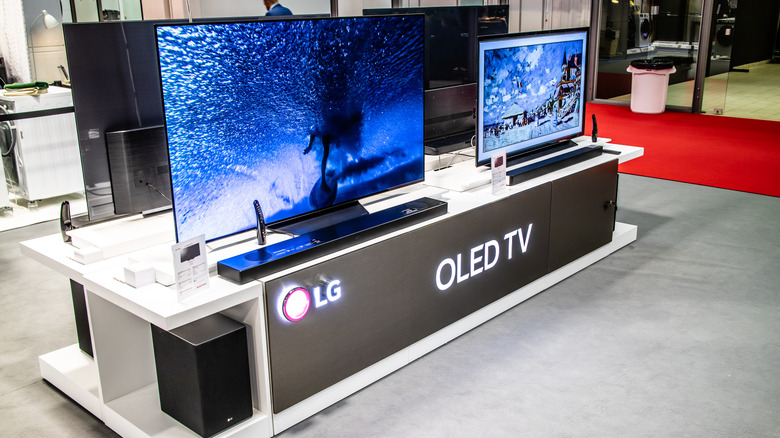LED Vs OLED: Which TV Technology Uses More Electricity?
There is so much to love about modern-day televisions. Of course, there are the obvious things like the picture quality, smart technology features, and 16:9 widescreen displays. Less obvious is how much more energy efficient today's sets are than TVs of yore. At one point, plasma TVs were all the rage, but their energy consumption could be between 300 and 500 watts per hour, which can put a real strain on your energy bill. Today, the most common TV types are LEDs and OLEDs, which are both dramatically more efficient than those plasmas.
LEDs are generally more energy efficient than OLED TVs. According to RTings' tool to determine your TV's electricity consumption, your typical 65-inch LED will utilize about 88 W per hour, whereas an OLED of the same size will use 116 W. Things get a little blurrier when you look at the typical overall ranges for these two technologies. The average LED wattage usage range is much narrower than an OLED. BKV Energy estimates that LEDs will consume anywhere from 50 to 100 W per hour. OLEDs, on the other hand, have an incredibly wide range that can be as little as 30 W per hour up to 200 W. The reason for this disparity is down to how each TV uses electricity.
How OLED and LED TVs are powered
Power is distributed very differently for the displays of LED and OLED TVs. This is the reason why the variance in power usage for OLED TVs ranges far more wildly than LEDs. LED TVs are illuminated using LED panels as backlighting for a liquid crystal display (or LCD), creating the image on your screen. The power is distributed pretty evenly among all of the panels, and that is why the average range for an LED TV's electricity consumption per hour is fairly narrow and consistent.
OLED TVs work very differently. Instead of light panels, every pixel on the TV is individually illuminated based on the needs of the picture being shown. That means if you are watching something that is very dark, your OLED will not illuminate any of the pixels that are true black in color. In this scenario, electricity usage would be low. However, in most cases, you need electricity to power nearly every pixel on your OLED TV. That reach of power is both why the high end of power consumption can be around 200 W per hour and ultimately why OLEDs use more electricity than LEDs. So, if you're buying a new TV, and picture quality is your highest priority, there's almost no better technology for TVs than OLED. However, if you want to save some money every month on your energy bill, go with an LED TV instead.

